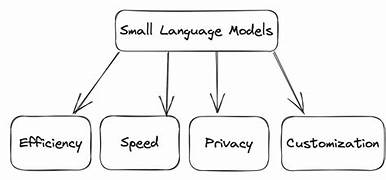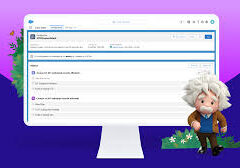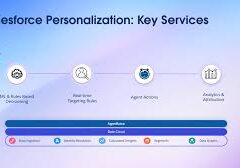The Role of Small Language Models (SLMs) in AI
While much attention is often given to the capabilities of Large Language Models (LLMs), Small Language Models (SLMs) play a vital role in the AI landscape. Role of Small Language Models.
Large vs. Small Language Models
LLMs, like GPT-4, excel at managing complex tasks and providing sophisticated responses. However, their substantial computational and energy requirements can make them impractical for smaller organizations and devices with limited processing power.
In contrast, SLMs offer a more feasible solution. Designed to be lightweight and resource-efficient, SLMs are ideal for applications operating in constrained computational environments. Their reduced resource demands make them easier and quicker to deploy, while also simplifying maintenance.
What are Small Language Models?
Small Language Models (SLMs) are neural networks engineered to generate natural language text. The term “small” refers not only to the model’s physical size but also to its parameter count, neural architecture, and the volume of data used during training.
Parameters are numeric values that guide a model’s interpretation of inputs and output generation. Models with fewer parameters are inherently simpler, requiring less training data and computational power. Generally, models with fewer than 100 million parameters are classified as small, though some experts consider models with as few as 1 million to 10 million parameters to be small in comparison to today’s large models, which can have hundreds of billions of parameters.
How Small Language Models Work
SLMs achieve efficiency and effectiveness with a reduced parameter count, typically ranging from tens to hundreds of millions, as opposed to the billions seen in larger models. This design choice enhances computational efficiency and task-specific performance while maintaining strong language comprehension and generation capabilities.
Techniques such as model compression, knowledge distillation, and transfer learning are critical for optimizing SLMs. These methods enable SLMs to encapsulate the broad understanding capabilities of larger models into a more concentrated, domain-specific toolset, facilitating precise and effective applications while preserving high performance.
Advantages of Small Language Models
- Targeted Precision and Efficiency: SLMs are crafted to address specific, niche needs within an organization. This specialization enables a level of precision and efficiency that general-purpose LLMs may struggle to achieve. For example, a legal-industry-specific SLM can handle complex legal terminology more effectively than a generic LLM.
- Economic Viability: The compact nature of SLMs leads to significantly lower computational and financial costs. Training, deploying, and maintaining an SLM require fewer resources, making them an attractive option for smaller businesses or specialized departments. Despite their smaller size, SLMs can match or even exceed the performance of larger models within their designated domains.
- Improved Security and Confidentiality: SLMs offer enhanced security and privacy due to their smaller size and greater manageability. They can be deployed on-premises or in private cloud environments, minimizing the risk of data breaches and ensuring sensitive information remains under organizational control. This is especially valuable in sectors handling confidential data, such as finance and healthcare.
- Quick Responsiveness and Low Latency: SLMs provide adaptability and responsiveness crucial for real-time applications. Their smaller scale results in lower latency, making them ideal for AI-driven customer service, real-time data analysis, and other scenarios where speed is critical. Their adaptability also allows for swift updates to model training, ensuring ongoing effectiveness.
Applications of Small Language Models
Role of Small Language Models is lengthy. SLMs have seen increased adoption due to their ability to produce contextually coherent responses across various applications:
- Text Prediction: SLMs are used for tasks such as sentence completion and generating conversational prompts.
- Real-time Language Translation: They help overcome linguistic barriers in communication.
- Customer Support: SLMs enhance chatbots and virtual assistants, enabling more natural and meaningful interactions.
- Content Creation: They generate text for emails, reports, and marketing materials, saving time and ensuring high-quality content.
- Data Analysis: SLMs perform sentiment analysis, named entity recognition, and market trend analysis, aiding in informed decision-making and strategic planning.
Small Language Models vs. Large Language Models
| Feature | LLMs | SLMs |
|---|---|---|
| Training Dataset | Broad, diverse internet data | Focused, domain-specific data |
| Parameter Count | Billions | Tens to hundreds of millions |
| Computational Demand | High | Low |
| Cost | Expensive | Cost-effective |
| Customization | Limited, general-purpose | High, tailored to specific needs |
| Latency | Higher | Lower |
| Security | Risk of data exposure through APIs | Lower risk, often not open source |
| Maintenance | Complex | Easier |
| Deployment | Requires substantial infrastructure | Suitable for limited hardware environments |
| Application | Broad, including complex tasks | Specific, domain-focused tasks |
| Accuracy in Specific Domains | Potentially less accurate due to general training | High accuracy with domain-specific training |
| Real-time Application | Less ideal due to latency | Ideal due to low latency |
| Bias and Errors | Higher risk of biases and factual errors | Reduced risk due to focused training |
| Development Cycles | Slower | Faster |
Conclusion
The role of Small Language Models (SLMs) is increasingly significant as they offer a practical and efficient alternative to larger models. By focusing on specific needs and operating within constrained environments, SLMs provide targeted precision, cost savings, improved security, and quick responsiveness. As industries continue to integrate AI solutions, the tailored capabilities of SLMs are set to drive innovation and efficiency across various domains.













